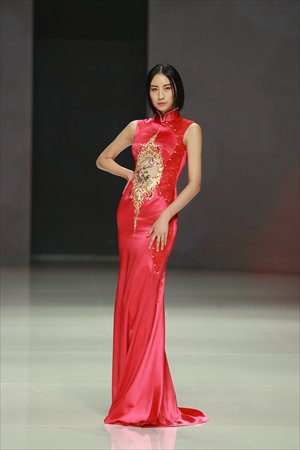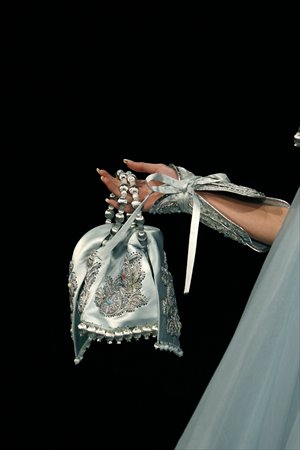Chinese fashion struts to the West


Top domestic brands help China's luxury industry gain int'l traction
Hermès, Louis Vuitton, Prada, Chanel, even people who are not interested in buying luxury products can name a few brands and recognize their logos in China now. Chinese consumers have become so powerful and obsessed with luxury items that many of the brands view the Chinese market as a cash cow. However, luxury fashion lovers elsewhere in the world may not be familiar with any Chinese brands.
Though not widely recognized, some domestic luxury brands are seeing healthy growth and showing potential to become well-known luxury lines.
Hong Huang, creator of Brand New China (a business dedicated to promoting local designers), wrote in her blog earlier this week that in the past decades, Chinese aesthetics and values used to be at the edge of mainstream fashion. But as brands like Exception de Mixmind, Ziggy Chen, Chictopia and ZUCZUG have emerged, Chinese fashion has begun to make some noise.
Brands with potential
For most Chinese consumers just learning the "luxury" concept, the items they want and have become familiar with are fashion products. Clothes, shoes, bags, watches and jewelry are on most wish lists.
But designing and producing these items are not China's strong suit. Due to differences in culture and custom, a typical list of luxury items in China is vastly different: liquor, tobacco, porcelain, furniture and tea. As a result, many firms that intend to create luxury fashion items fail to compete with brands from France and Italy and resort to copying their ideas.
"I am not producing a Chinese Cartier but a jewelry brand that belongs to China and speaks an international language," Wang Yunhe, president of Zhaoyi Jewelry, said on sina.com. Emerald with traditional Chinese handicrafts sounds a bit old-fashioned. But putting it into a modernized design and package can turn the "antique" into a fashionable luxury item with Chinese style. More importantly, it imbues the product with the Chinese culture of the emerald.
Qeelin, also a jewelry brand, provides China with another possibility of selling luxury items to the world. Its approach is to open a store in Paris targeting the foreign market firstly and directly. After seeing so many top luxury brands' stores in Paris, Chen Ruilin, the founder and designer of Qeelin, decided to become neighbors with them. Chen's shop is decorated with a bit of Buddhist style and each item purchased is boxed in the shop's signature look.
These brands along with Shanghai Tang, born in Hong Kong and now has dozens of stores around the world; and Franz Collection, originally from Taiwan and now selling fine porcelain in 56 countries, are all examples of companies profiting from China's well-established reputation for certain specialties.
However, as relative newcomers in the global luxury industry, Chinese brands are unable to speak of long-held traditions or legendary stories. Still there are ways to add a soul to the name.
Not built in a day
Wang Yuexin, editor-in-chief of Fashion Weekly told the Global Times that although there are a few relatively successful high-end Chinese brands in fashion, they are not on a scale to be qualified as "luxury brand," especially in women's and men's wear. While Chinese names are appearing more often in international magazines as designers, and dresses worn by Chinese actresses are catching attention on the red carpets of the world, the fame and reputation of a person or a dress cannot represent an entire brand.
Zhang Zhifeng's NE-Tiger and Rose Studio by Guo Pei are the most famous Chinese fashion brands in the world; both started with haute couture but now also produce ready-to-wear items. Cathy Horyn from The New York Times has reported on Guo and highly praised her designs. However, the two brands are largely based on the designers' personal reputations and have not become chain businesses like the best luxury brands in the global market.
Wang explained that many entrepreneurs and enterprises are aiming high but few have the resources and courage to achieve their goal. They understand building up a solid and reputable brand is not a one-day task. "The top luxury brands all started with a designer and developed for a century to turn a fashion studio into a real global business. Only time can solve many of the problems we have at the moment," said Wang.
Cai Sujian, the president of China Luxury Institute, a Hong Kong registered association, said the difference between top Chinese fashion brands and the world-class luxury brands mainly exists in the brand content, taking into account its originality, popularity, quality of services and cultural meaning.
"It is why NE-Tiger and Rose Studio products keep pace with the world standard in terms of craft and quality, but the brand as a whole still keeps a distance," said Cai.
Culture is key
In an article by Michel Gutsatz published in Forbes last year, Qeelin was described as a brand that successfully combines traditional Chinese culture with French techniques. He emphasized that this is an advantage of the brand management but does not necessary lead to a real luxury brand. And it's the same for the rest of the Chinese high-end fashion brands.
"The soul of a brand and fashion industry is its culture. Without culture, great investments and extremely high prices do not define the brand as luxury," said Wang.
Cai pointed out that a key issue here is that China does not have a clear modern culture. Modernism or postmodernism, contemporary culture in China is hugely influenced by the West so developing an original culture is at the issue's core.
For Wang, the culture we are talking about does not necessarily refer to any symbolic figure: "China today is within the globalized context. As long as the products are designed and made in China, they represent China, with or without looking Chinese."